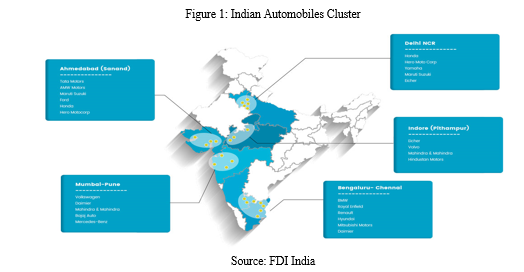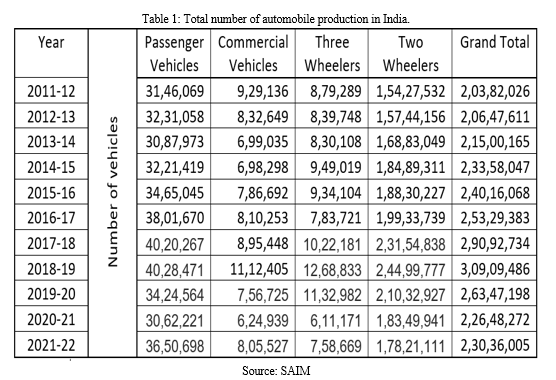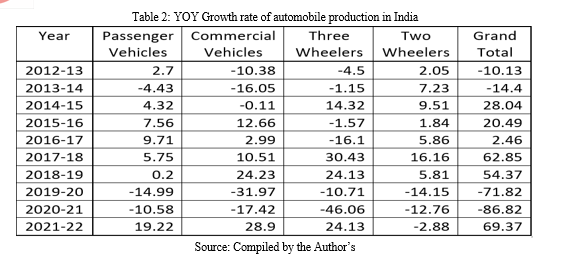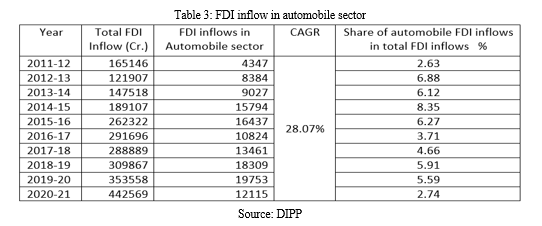Ijraset Journal For Research in Applied Science and Engineering Technology
- Home / Ijraset
- On This Page
- Abstract
- Introduction
- Conclusion
- References
- Copyright
Analyzing the Impact of FDI in the Automobile sector: An Empirical Study with Special Reference to India
Authors: Shivani Singh, Disha Singh
DOI Link: https://doi.org/10.22214/ijraset.2023.55094
Certificate: View Certificate
Abstract
Indian automobile industry has grown rapidly and become a major contributor to the country\'s economy. It produces a wide range of vehicles like cars, motorcycles, commercial vehicles, and tractors for both Indian and international markets. The industry has attracted investments and boosted related industries like component manufacturing. The Indian government has implemented favourable policies to support the sector, including initiatives for electric vehicles. In this paper growth and progress of the Indian automobile industry are studied using secondary data for the period of 2011-12 to 2021-2022. The study found that, FDI inflows and its share in total FDI both significantly increased in the years 2021–2022. Consistent FDI inflows into the automobile industry promote related to technology advancement, the creation of employment opportunities, and the growth of India\'s automotive sector as a whole.
Introduction
I. INTRODUCTION
Indian automobile industry has become one of the economy's fastest-growing industries. With a rich history that dates back to the early 1900s, India's automotive sector has witnessed significant growth and transformation over the years. Today, it stands as a prominent player in the global automobile market, showcasing its prowess in manufacturing, innovation, and technological advancements.
The Indian automobile industry encompasses a wide range of vehicles, including cars, motorcycles, commercial vehicles, and tractors. It serves both domestic and international markets, catering to the diverse needs and preferences of consumers.
India's automotive sector has become a major contributor to the country's economic growth, employment generation, and technological advancement. It has attracted significant investments from both domestic and international players, fostering a competitive and vibrant market environment. The industry has also played a crucial role in boosting ancillary industries, such as manufacturing of components, spare parts, and accessories, further strengthening the overall automotive ecosystem.
The Indian government has implemented in place several policies and initiatives To support the development of the automobile sector in India. These initiatives are intended to boost manufacturing capacity, stimulate innovation, support sustainability, and attract in investment.
The following are some of the major policies and initiatives:
- Automotive Mission Plan: The Automotive Mission Plan is an initiative of the government with the goal of establishing India as the preferred destination for automotive development, research, and manufacturing worldwide. Its main objectives are to increase sector competitiveness, support sustainable growth, and generate job opportunities.
- Make in India: The Indian government's Make in India initiative promotes the production of goods in India by domestic as well as foreign companies. It creates a supportive business climate, encourages ease of doing business, and gives various kinds of incentives that encourage investment in the automobile industry.
- The National Electric Mobility Mission Plan (NEMMP): Developed to encourage the use of electric vehicles (EVs) in India. To encourage the production and deployment of EVs, it involves several initiatives, including financial incentives, support for research and development, and the installation of charging infrastructure.
- Faster Adoption and Manufacturing of Electric Vehicles: The NEMMP includes a scheme called "Faster Adoption and Manufacturing of Electric Vehicles" (FAME). It supports the construction of charging infrastructure, encourages EV technology research and development, and offers financial incentives to buyers of electric and hybrid vehicles.
- Skill Development Initiatives: The government has put in place programs and initiatives that cater to the skill requirements of the sector. These seek to educate workers and improve their employability in the auto industry, generating a competent workforce and assisting the expansion of the sector.
- Foreign Direct Investments: In order to entice foreign investment in the automotive industry, the Indian government has put in place a supportive policy framework. The FDI policies in India are created and governed by the Department for Promotion of Industry and Internal Trade (DPIIT). Under some restrictions, the FDI policy permits 100% FDI through the automated route for the production of automobiles.
The government's devotion to fostering and supporting India's automobile sector is seen in these initiatives and programs. They seek to provide a supportive environment for business, support sustainability and innovation, attract in investment, and stimulate the industry's expansion in coordination with the country's economic and developmental goals.
Foreign Direct Investment (FDI) has played a significant role in the growth and expansion of the automobile sector in India. Recognizing the important role of FDI in advancing technology, boosting manufacturing capacity, and fostering exports, the Indian government has strongly supported FDI in the automotive industry through a variety of regulations and initiatives.

II. REVIEW OF LITERATURE
- Rajesh and Dileep (2013), conducted a study titled “Foreign Direct Investment in Indian Automobile Industry”, this paper discussed that the automobile sector acts as a catalyst for various other sectors. The scope of the Indian automobile sector has expanded as a result of the liberalization of FDI regulations by the government. The first company was Suzuki to enter the Indian automobile industry. 1983 the Indian government later approved this company to enter the domestic automobile market. The Indian government liberalized this sector's regulations in 1991, permitting FDI into the automobile sector. The Indian automobile industry's passenger vehicle sector opened its doors to FDI in 1993. The paper examines the development of FDI in the Indian automobile sector to the present.
- Bhasker and SubrahmanyaSarma (2013), in this paper titled “Role of Foreign Direct Investment – FDI: in the growth of Automobile Industry in India”, this paper studied that FDI has a major contribution to the growth of the economy. It is required mainly through investments in equity or the formation of subsidiaries, the transfer of managerially-skilled technology, and the application of improved management techniques that lower costs and can even boost productivity. The paper also emphasizes how important the automotive industry has contributed to GDP growth. The paper focuses on FDI and how it contributes to India's growing automobile exports and automobile production. This study concluded that Foreign Direct Investment (FDI) in the automobile industry has been one of the most important factors in India's consistent growth in production, sales, and export revenue. The key factor for the automobile industry's ongoing development in India has been foreign direct investment (FDI), together with purchasing power capacity and auto-financing facility – production, and sales with a variety covering all the categories and export revenues.
- Rajalakshmi and Ramachandran (2011) discussed that Foreign direct investment (FDI) inflows into India's automobile sector have significantly increased as a result of economic liberalization and the sector's 18% annual growth rate. Along with a well-established auto ancillary sector, testing facilities, and R&D centers, India provides benefits including modern technology, cost-effectiveness, and trained labor. The country ranked second for two-wheeler manufacturing and third for three-wheeler manufacturing. The United States, Japan, United Kingdom, Germany, the Netherlands, Mauritius, and South Korea are essential investing countries. However, there are reasons for concern given that FDI inflows decreased to $18.35 billion in the first 11 months of 2010-2011 from $63 billion the year before. However, the automobile industry in India strives for greater expansion and has the ability to outperform overseas companies.
- Smita Miglani (2019) discussed in the paper that automobiles play an essential role in the financial development of India, as it has a prominent position in international production networks. The expansion of the industry was fueled by government support. This industry's growth has been supported by strong government support, which has allowed it to carve out a space for itself among India's industrial sectors. In contrast to other vehicle-producing businesses, the United States explicitly targets low- and middle-income consumers with its automobile production. India was the fourth-largest auto market in the world in 2017, and there is a rising demand for Indian automobiles both domestically and internationally.
- Kale, and Dinar (2017) in this paper discussed the growth of the automobile sector, which was later promoted in the microeconomic environment that the Indian government helped to construct, and has been largely attributed to the policies of the Indian government. In addition to the major effects of fiscal policy instruments, industrial policy also had an impact on business-level knowledge acquisition and shaped the development of technological competence.
- Kumar and Agarwal, (2023), in their study attempts to identify numerous issues and regulations relating to foreign direct investment in India and its potential for the growth of the Indian automobile sector. To find the required data for analysis, "primary and secondary data collection methods" were employed for this purpose . The study was conducted using a random sample technique. A total of 110 manufacturers from the car sector were selected. All of the data were evaluated using a regression model while utilising a descriptive quantitative research technique. The results of the data analysis shows that FDI has had a major effect on "India's Development of the Automobile Industry."
- Abhishek Vijaykumar Vyas (2015), in his study concentrated on FDI patterns in India from 2000–1 to 2014–15 (as of June 2015). The report also examines FDI approvals by nation for India and FDI approvals by industry for the time frame of April 2000 to June 2015. The analysis is based on secondary data that was gathered from the World Investment Report, Government of India, Reserve Bank of India, Department of Industrial Promotion and Policy, and Ministry of Commerce and Industry papers. The analysis comes to the conclusion that Mauritius has become the most important source of FDI. It is because most foreign nations prefer to invest in the service sector and India and Mauritius have a Double Taxation Avoidance Agreement (DTAA).
- Ghosh and Roy, (2015) in their paper examines how ownership, worker productivity, and the purchase of technology affected firm-level labour demand in the Indian manufacturing sector after 2000. Except for the food and beverage sector, it was discovered that ownership had no discernible effect on employment in businesses. With the exception of the chemical industry, an increase in the average salary had a negative influence on firm-level labour demand.
- Jaswal et al., (2022): FDI has been a significant contributor to India's financial development, both on a macro and sector level, as the country's trade regulations have become more lenient. Globally, there is much argument over the relationship between "Foreign Direct Investment (FDI)" and economic progress. The volatility of the inflows is influenced by a range of regional, global, and national events. A wide range of industries, including metals, construction, cars, computers, and electronics, are anticipated to benefit from FDI.
III. OBJECTIVES OF THE STUDY
The study has been conducted with the following objectives to study the growth and performance of automobiles in India:-
- To study the trends of the production of automobiles in India.
- To study the progress of the automobile industry in India through FDI inflows.
IV. RESEARCH METHODOLOGY
This research work is both descriptive and analytical in nature, and the purpose of the study is to analyze the growth of the automobile industry in India through FDI inflows. The study is uses secondary data which are collected from various websites, and reports of the Department of Industrial Policy and Promotion (DIPP), Society of Indian Automobile Manufactures (SAIM).
The period of the study is selected from 2011-12 to 2021-22. Using statistical tools like percentage, compound annual growth rate (CAGR), and YOY growth rate, for the purpose of the study, tables, and graphs used to present, analyze, and interpret the data of the study.
V. DATA ANALYSIS AND INTERPRETATION
The study is to analyze the growth of the Indian automobile industry through the amount of FDI inflows in this sector. For the study automobile sector is categorized into four parts i.e. Passenger vehicles, Commercial vehicles, three-wheelers, and two-wheelers vehicles.

Table 1 presents the Indian automobile production trends for the study period of ten years spanning from 2011-12 to 2021-22. From 2011-12 to 2015-16, the Indian automobile industry experienced steady growth in production.
The number of vehicles manufactured each year consistently increased, with a significant rise from 31,46,069 vehicles in 2011-12 to 34,65,045 vehicles in 2015-16. This positive trend can be attributed to factors such as rising consumer demand, favorable government policies, and overall economic growth. However, the period from 2016-17 to 2019-20 witnessed a slight fluctuation and subsequent decline in automobile production. Despite facing temporary setbacks and challenges such as the implementation of the Goods and Services Tax (GST) and an economic slowdown, the industry managed to maintain relatively stable production figures. The highest production during this period was achieved in 2017-18, with 40,20,267 vehicles, followed closely by 2018-19, with 40,28,471 vehicles.
The year 2020-21 marked a significant drop in automobile production, with only 30,62,221 vehicles manufactured. There is seen rise in automobile production with 36,50,698 in 2021-22.
This decline can be attributed to various factors, primarily the impact of the COVID-19 pandemic. The pandemic led to disruptions in supply chains, reduced consumer demand due to economic uncertainties, and temporary shutdowns of manufacturing facilities. The automobile industry was significantly affected by the pandemic-induced lockdowns and restrictions, resulting in a notable decrease in production compared to previous years.

- Passenger Vehicles: The production of passenger vehicles experienced fluctuations throughout the period. There were both positive and negative growth rates, with significant increases observed in 2015-16 (7.56%) and 2021-22 (19.22%).
- Commercial Vehicles: Commercial vehicle production also showed variations, with both positive and negative growth rates. The category experienced substantial growth in 2018-19 (24.23%) and 2019-20 (24.13%).
- Three Wheelers: Three-wheeler production had mixed trends. Noteworthy growth occurred in 2017-18 (30.43%) and 2021-22 (24.13%).
- Two Wheelers: Two-wheeler production shows varied growth rates. Notable increases were observed in 2014-15 (9.51%) and 2017-18 (16.16%).
- Grand Total: The overall production trend, represented by the grand total, shows variations throughout the period. The most significant growth was observed in 2017-18 (62.85%) and 2021-22 (69.37%).The trends are influenced by various factors such as economic conditions, consumer demand, policy changes, and external events like the COVID-19 pandemic.

Table 3 represents the FDI inflows specifically in the automobile sector in India, the compound annual growth rate (CAGR) of FDI inflows, and the share of automobile FDI inflows in the total FDI inflows.
Significant FDI inflows into the automotive industry were seen in India over the past decade, which spanned from 2011–12 to 2021–22. The overall amount of FDI received during this time period was 3,009,767 crore rupees. FDI inflows in the automotive industry fluctuated but exhibited a general rising tendency. The sector's FDI inflows had a compound annual growth rate (CAGR) of 28.07%.
The importance of the automotive industry in attracting foreign investment is demonstrated by an increase in the share of FDI inflows in the total amount of FDI from 2.63% in 2011–12 to 11.81% in 2021–22. Notably, the automobile industry's FDI inflows and its share in total FDI both significantly increased in the years 2021–2022.


Conclusion
The study discussed the growth and performance of the Indian Automobile industry through FDI inflows. Indian automobile industry witnessed consistent growth from 2011-12 to 2015-16, followed by a period of slight fluctuation and subsequent decline in production from 2016-17 to 2019-20. The year 2020-21 recorded a significant drop in production due to the COVID-19 pandemic. The industry\'s performance was influenced by various factors, including consumer demand, government policies, economic conditions, and the pandemic\'s impact on global supply chains and consumer behaviour. Japan is the dominating country with a 21.81 percent share in total FDI inflows, followed by Switzerland. The study found that the automobile industry\'s FDI inflows and its share in total FDI both significantly increased in the years 2021–2022. Consistent FDI inflows into the automobile industry promote related to technology advancement, the creation of employment opportunities, and the growth of India\'s automotive sector as a whole.
References
[1] Ghosh, M., & Roy, S. S.(2014). FDI, Technology Acquisition and Labour Demand in an Emerging Market Economy, The Journal of Industrial Statistics, 4 (I), 19-36. [2] India’s automobile sector-with reference to passenger car segment, 1(1). [3] Jaswal, I., Badri Narayanan G, & Jain, S. (2022). Can the Post-COVID FDI Boost the Indian Economy? Vision, 09722629211066286. [4] K. Rajalakshmi, Dr. T. Ramachandran (2011), Impact of foreign direct investment on [5] Kale, Dinar (2017). “Sources of innovation and technology capability development in the Indian automobile industry.” Institutions and Economies, 121–150. [6] Kumar, A., & Agarwal, M. (2023). Studies on challenges and opportunities for foreign direct investment in the automobile industry in India. The Scientific Temper, 14(02), 273-281. [7] Miglani, S. (2019). The growth of the Indian automobile industry: Analysis of the roles of government policy and other enabling factors. In Innovation, economic development, and intellectual property in India and China (pp. 439-463). [8] Rajesh, T.and Dileep,A.S. (2013). Foreign Direct Investment in Automobile Industry.Intenational Journal of Current and Academic Review, 1(3), 33- [9] Vijay Bhasker, V., and Subrahmanya Sarma, Y.V.S., (2013). Role of Foreign Direct Investment – FDI: in the growth of Automobile Industry in India, Research Journal of Management Sciences, 2(1), 13-20. [10] Vyas, A. V. (2015). An analytical study of FDI in India. International Journal of Scientific and Research Publications, 5(10), 1-30. [11] http://siaminfo.in/statistics.aspx?mpgid=8&pgidtrail=9 [12] https://dpiit.gov.in/fdi-publications [13] https://static.pib.gov.in/WriteReadData/specificdocs/documents/2023/feb/doc2023217160601.pdf [14] https://www.ibef.org/industry/india-automobiles
Copyright
Copyright © 2023 Shivani Singh, Disha Singh. This is an open access article distributed under the Creative Commons Attribution License, which permits unrestricted use, distribution, and reproduction in any medium, provided the original work is properly cited.

Download Paper
Paper Id : IJRASET55094
Publish Date : 2023-07-29
ISSN : 2321-9653
Publisher Name : IJRASET
DOI Link : Click Here
 Submit Paper Online
Submit Paper Online

